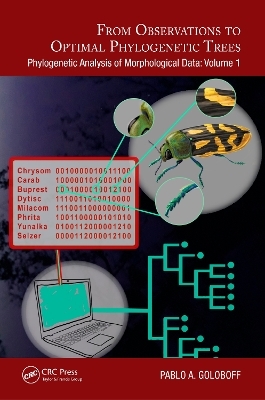
From Observations to Optimal Phylogenetic Trees
CRC Press (Verlag)
978-1-032-11487-3 (ISBN)
Taxonomists specializing in different groups once based phylogenetic analysis only on morphological data; molecular data was used more rarely. Although molecular systematics is routine today, the use of morphological data continues to be important, especially for phylogenetic placement of many taxa known only from fossils and rare or difficult to collect species. In addition, morphological analyses help identify potential biases in molecular analyses. And finally, scenarios with respect to morphology continue to motivate biologists: the beauty of a cheetah or a baobab does not lie in their DNA sequence, but instead on what they are and do! This book is an up-to-date revision of methods and principles of phylogenetic analysis of morphological data. It is also a general guide for using the computer program TNT in the analysis of such data. The book covers the main aspects of phylogenetic analysis and general methods to compare classifications derived from molecules and morphology. The basic aspects of molecular analysis are covered only as needed to highlight the differences with methods and assumptions for analysis of morphological datasets.
Born in Buenos Aires, Pablo A. Goloboff became interested in spider biology and systematics in the late 70’s, in the Museo Argentino de Ciencias Naturales. His first papers (published during the 80’s) were on spider systematics, but he soon became more interested in systematic theory and phylogenetic methods. He graduated with a Licenciatura in Biology in 1989, from Universidad de Buenos Aires, and then pursued doctoral studies in Cornell University and the American Museum of Natural History, in New York, between 1989 and 1994. He published his first methodological papers in the early 90’s, gradually switching his research from spider systematics to systematic theory. During his stay at Cornell University, he became more involved with quantitative methods for parsimony analysis, and wrote his first computer programs. He moved to Tucumán in 1994, to work for the CONICET, and continued working on theory and methods for systematics and historical biogeography. He has published over a hundred scientific papers and about a dozen computer programs, the best known of which are Nona, Piwe, TNT (for phylogenetics), and VNDM (for biogeography). He is a Fellow Honoris Causa of the Willi Hennig Society, and served as President of the society from 2004 to 2006. Since 1995, he has been regularly teaching courses on phylogenetics in Argentina and about a dozen countries.
Preface. Author Biography. Abbreviations. Introduction to Phylogenetics. Characters, Homology, and Datasets. Character Optimization: Evaluation of Trees and Inference of Ancestral States. Models and Assumptions in Morphology. Tree Searches: Finding Most Parsimonious Trees. References. Index.
| Erscheinungsdatum | 19.04.2022 |
|---|---|
| Reihe/Serie | Species and Systematics |
| Zusatzinfo | 4 Tables, black and white; 29 Line drawings, black and white; 29 Illustrations, black and white |
| Verlagsort | London |
| Sprache | englisch |
| Maße | 156 x 234 mm |
| Gewicht | 550 g |
| Themenwelt | Naturwissenschaften ► Biologie ► Evolution |
| Naturwissenschaften ► Geowissenschaften ► Mineralogie / Paläontologie | |
| ISBN-10 | 1-032-11487-8 / 1032114878 |
| ISBN-13 | 978-1-032-11487-3 / 9781032114873 |
| Zustand | Neuware |
| Informationen gemäß Produktsicherheitsverordnung (GPSR) | |
| Haben Sie eine Frage zum Produkt? |
aus dem Bereich


